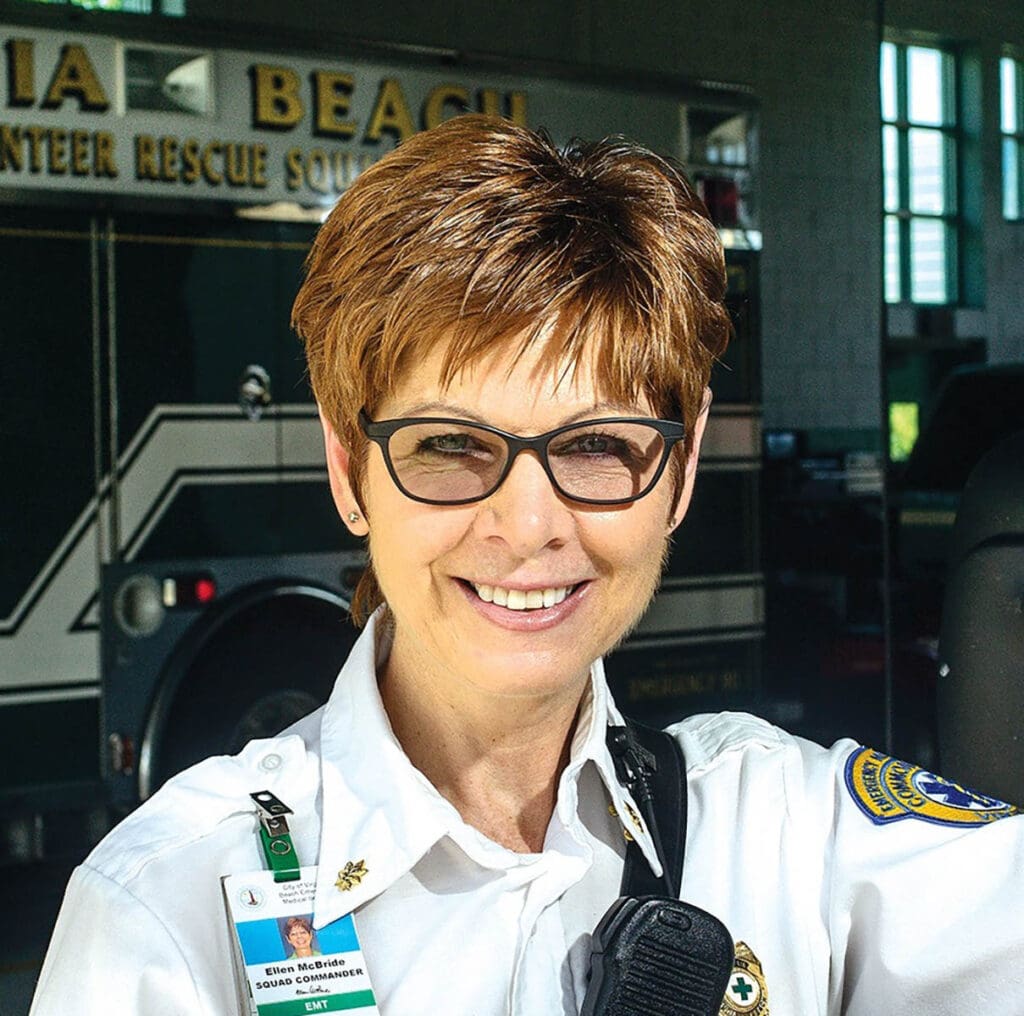Longtime volunteer Ellen McBride embodies the heart of VB Rescue’s community mission
By Betsy DiJulio
It’s Wednesday at 4:30 a.m. Ellen McBride’s alarm has just sounded as it has every week since 2007. Rising before the sun comes up, McBride begins filling her uniform pockets with all the items she carefully laid out on her dresser the night before, albeit no longer with a knot in her stomach: ID badge, watch, ring, gloves, pocket knife, a pad of paper for recording patient info, pens—“you ALWAYS need at least two pens”—and her Leatherman Raptor. This indispensable scissor tool serves as trauma shears, O2 bottle key, seatbelt cutter, and measuring device.
Though all other weekdays find her at Red Chalk Studios in Virginia Beach where she is the longtime Marketing Communications Director, McBride is a life member and past chief of the Virginia Beach Volunteer Rescue Service (VBVRS) and first volunteer deputy chief of the Virginia Beach Department of Emergency Medical Services (EMS). “It isn’t supposed to work,” she quips in regard to the nation’s largest—and award-winning—volunteer-based emergency medical services system located in Virginia Beach. But it does…and how. For some 80 years.
VB Rescue is an umbrella brand for ten squads—not to be confused with VBVRS, which is but one of them—plus a Marine Rescue Team. And while McBride attributes the success of VB Rescue to many factors, including its connection via training, direction, and policy to the Virginia Beach Department of EMS (the third largest and busiest in the nation), topping the list is this: “The people are just amazing.”
The squads, each with their own identity and history, comprise this cohesive system of more than 1,000 highly skilled and trained members. These nonprofit 501(c)3 entities arose organically in the 1950s to serve as first responders and medical transport in specific neighborhoods and sections of the city. The longevity of the network is a story of independence and cooperation, a complex web of both City and Virginia Beach Rescue Squad Foundation support and independent community-based fundraising for ambulances and more.

Each year, 150 full-time, uniformed, career professionals, who staff those ambulances, offer advanced care, and hold supervisory positions, are joined by the volunteers of VB Rescue to respond to approximately 56,000 calls, a service valued at $23 million over 12 months. City dispatchers field these 911 calls from among the 450,000 residents of Virginia Beach and the 2.8 million tourists who visit the resort annually. And the call load has continued to rise every year except during COVID.
Volunteers come in “all makes and models,” according to McBride, running the gamut of ages, genders, education—some are current students—civilian and military employment, and retirement. Likewise, the two-person ambulance teams are a “mix and match” of a paid employee plus a volunteer, two volunteers, or two paid employees with, at times, a third student or intern.
Whether paid or volunteer, these professionals receive the same training and operate under the same medical direction and protocols. The difference between EMTs like McBride, Advanced Level Providers, and Paramedics lies largely in the type of invasive procedures they are allowed to perform and the type of drugs they are allowed to administer.
Every month, McBride’s long but immensely rewarding duty days allow her to satisfy her required time commitment determined by length of service, typically 40 hours per month. Her ongoing impetus to get up before the sun, especially on cold or rainy mornings, is “some kind of need to fix or to comfort.” And not just patients, but also family members. “We don’t just provide medical care,” she explains, but other kinds of care and support that matter just as much.
Whether responding to chest pains, trauma, or seemingly mild symptoms, McBride asserts that “If it’s an emergency to you, it’s an emergency to me.” Listing friendliness and approachability as her secret sauce, she explains, “You just have to be whatever (the person) needs.” With a soft spot for mental patients, who often don’t present with readily identifiable medical symptoms but whose needs are just as great, she finds that they especially appreciate being talked directly to, not about.
But the patients and loved ones aren’t the only ones who benefit. For the volunteers, the knowledge, confidence, leadership, and ability to pivot on a dime—not to mention a keenly developed spidey-sense—far outlast the hours of a shift. But the nature of this volunteer service has changed. McBride notes that “people typically don’t stay as long as I have.” Many go on to school and paid positions. And the sense of “deep camaraderie” has shifted because “there is not as much time to sit around the station and hear stories like we used to.” There’s typically not even time for lunch.
Still, Ellen treasures the bonds she forms with each partner by virtue of spending 12 high-stakes hours together, mutually reliant on each other in intense situations. At the end of a shift, it is comforting to know that one other person in the world knows exactly what you experienced that day, uniting partners in ways not replicated in other professions. And, she says, when the outcomes are worth celebrating, “we can look at each other and say, ‘We did that!’”
Driving home from duty as the sun is setting, McBride says, “I am typically bone tired, my feet hurt, and I’m hungry. But more than anything, I’m deeply satisfied and grateful, and that’s an amazing feeling.”
To learn more about this life-changing
and life-saving volunteer work, visit www.VBRescue.org.


























